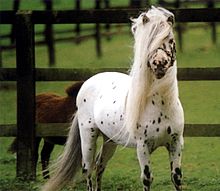The Falabella is an Argentine breed of small horse. It is among the smallest of horse breeds, with a height at the withers in the range 63–86 cm (25–34 in).[3]: 465 .
 A stallion | |
| Conservation status | |
|---|---|
| Other names |
|
| Country of origin | Argentina |
| Distribution | Americas, Europe |
| Standard |
|
| Traits | |
| Weight | |
| Height | |
History
editThe horses of South America descend from Andalusian and other Iberian stock brought to the western hemisphere by the Spanish. In the southern part of the continent, significant numbers of these horses developed within geographically isolated conditions and by the mid-nineteenth century there were some small, inbred animals in the herds of Mapuche of southern Buenos Aires province in Olavarría, Argentina.[4] The Falabella was originally developed in Argentina from local horses of Criollo stock, beginning in 1868 with the breeding program of Patrick Newtall. When Newtall died, the herd and breeding methods were passed to his son-in-law, Juan Falabella. He added additional bloodlines, including the Welsh Pony, Shetland pony, and small Thoroughbreds. With considerable inbreeding, he was able to gain consistently small size within the herd.[citation needed]
Beginning in the 1940s, a descendant, Julio C. Falabella, created a formal breed registry, the Establecimientos Falabella, now the Asociación de Criadores de Caballos Falabella (Falabella Horse Breeders Association), and worked to standardize the breed to reach a consistent height, first achieving an average size of under 100 cm (40 in) Later breeders developed the modern standard, a horse breed that averaged approximately 76 cm (30 in) in height.[4]
Characteristics
editThe height of a fully-grown Falabella varies between 71 and 86 cm (28 and 34 in).[5] Falabella foals are very small, standing around 30 to 56 cm (12 to 22 in) tall at birth, and maturing to their adult height by the age of three.[6]
The Falabella has the proportions of a horse, with conformation similar to that of a Thoroughbred or Arab. The body is small and compact, with a sleek coat and a slim frame.[citation needed]
Bay (or a variant of bay, called "brown") and black are the most common colors, but there are also pintos, palominos and other spotting patterns found. Black or red leopard-spotted Falabellas (resembling, but not the same as the Appaloosa horse breed) also exist, but are not common.[4]
Use
editThe Falabella is kept as a pet or for show.[7]: 508 It can be ridden by children no more than about eight years old, or trained to perform tricks or pull a small cart.[8]: 96
References
edit- ^ Barbara Rischkowsky, Dafydd Pilling (editors) (2007). List of breeds documented in the Global Databank for Animal Genetic Resources, annex to The State of the World's Animal Genetic Resources for Food and Agriculture. Rome: Commission on Genetic Resources for Food and Agriculture, Food and Agriculture Organization of the United Nations. ISBN 9789251057629. Archived 23 June 2020.
- ^ a b c d e Breed data sheet: Falabella Pony / Argentina (Horse). Domestic Animal Diversity Information System of the Food and Agriculture Organization of the United Nations. Accessed December 2020.
- ^ a b Valerie Porter, Lawrence Alderson, Stephen J.G. Hall, D. Phillip Sponenberg (2016). Mason's World Encyclopedia of Livestock Breeds and Breeding (sixth edition). Wallingford: CABI. ISBN 9781780647944.
- ^ a b c "Falabella miniature horse." from International Museum of the horse
- ^ Falabella Miniature Horse Association
- ^ Lynghaug, Fran (15 October 2009). The Official Horse Breeds Standards Guide. Voyageur Press. p. 481. ISBN 9781616731717.
- ^ Élise Rousseau, Yann Le Bris, Teresa Lavender Fagan (2017). Horses of the World. Princeton: Princeton University Press. ISBN 9780691167206.
- ^ Richard I. Robinson (July 1965). Falabella Miniature Horses. The Western Horseman. July 1965: 96–98.
External links
edit- Media related to Falabella at Wikimedia Commons